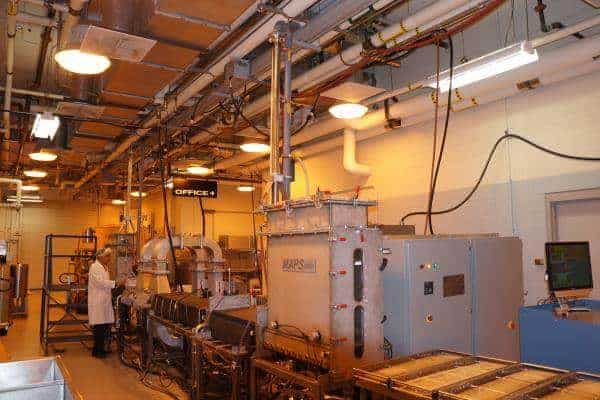major challenge to our food system is feeding a growing population that is projected to exceed nine billion in just the next three decades. This challenge requires both increasing food production and protecting the safety of our food supply in the face of a changing climate and diminishing land and water resources.
According to a recent report by the U.S. Global Change Research Program (link is external), rising atmospheric and ocean temperatures are expected to increase the exposure of food to certain pathogens (disease-causing bacteria, fungi, viruses, and small parasites). For example, significantly warmer coastal waters in Alaska from 1997 to 2004 were associated with an outbreak in 2004 of Vibrio parahaemolyticus. This bacterium is one of the leading causes of seafood-related gastroenteritis (“food poisoning”) in the United States and is associated with the consumption of raw oysters harvested from warm-water estuaries. Air temperature also affects pathogen levels of multiple species of Vibrio in shellfish., For example, Vibrio vulnificus may increase 10- to 100-fold when oysters are stored at ambient temperatures for 10 hours before refrigeration, potentially necessitating changes in post-harvest controls to minimize the increased risk of exposure.
To mitigate such threats, researchers are developing methods for predicting and detecting the emergence and preventing the spread of harmful microorganisms such as Vibrio species. A team based at the University of North Carolina at Chapel Hill and funded by the U.S. Department of Agriculture’s National Institute of Food and Agriculture (NIFA) is developing models that will help seafood producers predict when the public will be at increased susceptibility to foodborne illness from oysters and other shellfish. Other research groups are beginning to use DNA sequencing technologies to rapidly and affordably identify which microbes are present on the surface of foods. For example, NIFA-funded researchers at the University of New Hampshire have developed a new screen that is based on a set of genetic markers that should improve detection and surveillance of V. parahaemolyticus (link is external) in seafood.
Extreme weather events, such as drought and flooding, may also increase the risk of food exposure to pathogens. Drought can increase the concentration of pathogens in water that is used for irrigation, livestock management, food handling, or storage. Intense bursts of heavy rainfall may lead to flooding, potentially contaminating this water supply with other waters that carry sewage, manure, or other foodborne contaminants. A NIFA-funded research team based at Colorado State University is trying to understand the specific conditions that favor the production of cyanotoxins by certain classes of cyanobacteria that can exist in agricultural ponds. Cyanotoxins are responsible for animal poisonings in a majority of the in the United States and more than 50 countries globally. Surface temperatures of water have increased due to climate change, leading to a higher frequency of these toxic algal bloom occurrences.
Increased average temperatures and humidity can also increase the prevalence of molds that produce toxic chemicals such as mycotoxins. Prior to harvest, warmer temperatures and drought can stress plants, making them more susceptible to mold growth. Warm and moist conditions favor mold growth and affect the biology of insects that transmit molds to crops. If crops are not dried and stored at low humidity, mold growth and mycotoxin production can increase to very high levels. Once introduced into the food chain, these poisonous toxins can lead to acute and chronic health issues.
Consumer education is a critical piece to ensuring a safe food supply. NIFA-funded researchers at Kansas State University and Tennessee State University found that bagging poultry at the meat counter in grocery stores can reduce the spread of bacterial contamination of other food items, the grocery cart, people, and refrigerators. The same research team also emphasizes the importance of using a thermometer to check the doneness of cooked meat. Many kitchens are lit by energy efficient lights that often make meat appear more cooked than it actually is, making visual inspection no longer a reliable test for doneness.
In addition, to protect our food supply from contamination while maintaining the quality of ready-to-eat meals, NIFA-funded researchers at Washington State University have developed microwave-assisted thermal sterilization (MATS) and pasteurization systems (MAPS). These systems use a combination of microwave heat and hot water to rapidly heat and briefly hold packaged food at sterilization or pasteurization temperatures before quickly cooling the food. These systems currently operate at several locations around the United States, and major consumer food companies in Singapore and India have recently purchased the systems.
Taken together, rising global temperatures and changes in weather extremes are likely to increase the exposure of food to certain pathogens and toxins. It is therefore increasingly important to implement practices that will protect the safety of our food.
If our reporting has informed or inspired you, please consider making a donation. Every contribution, no matter the size, empowers us to continue delivering accurate, engaging, and trustworthy science and medical news. Independent journalism requires time, effort, and resources—your support ensures we can keep uncovering the stories that matter most to you.
Join us in making knowledge accessible and impactful. Thank you for standing with us!

